Where Do Butterflies Get Their Color?
These colors come from two sources. The first are pigmented colors which are simply ordinary chemical pigments that absorb certain wavelengths of light and reflect others. The wavelengths that are reflected are the colors that you’ll see. An example would be that the shades of brown and yellow seen in most butterflies comes from melanin, the same pigment that tans your skin when you sit in the sun. When light hits the object it absorbs all the colors except the shades that create brown or yellow.
The second source of color is called structural color and results from the specific structure of the butterflies’ wings. Butterfly wings are covered by lots of little scales which layer on top of each other and are separated by little pockets of air. Because of this structure color appears to shimmer and shift as an observer moves is actually a light effect known as iridescence. Iridescence occurs when light comes through transparent multilayered surfaces and is reflected more than once. All the reflections concentrate and compound each reflection, causing more vibrant visual displays of color. Using spectrophotometers like Instrument Systems’ MAS 40, scientists have measured the degree of iridescence in both butterflies and other creatures like hummingbirds to gain an increased understanding of how these adaptations have effected their ability to survive as well as merely investigating how these structural effects influence animal behavior and development.










